








1- 73 % back more state funding for K-12 education.
2- A majority favors shifting $$ from non-education budget areas.
3- Fewer than 1 in 5 would cut school programs or grow class sizes.

1- 73 % back more state funding for K-12 education.
2- A majority favors shifting $$ from non-education budget areas.
3- Fewer than 1 in 5 would cut school programs or grow class sizes.

















